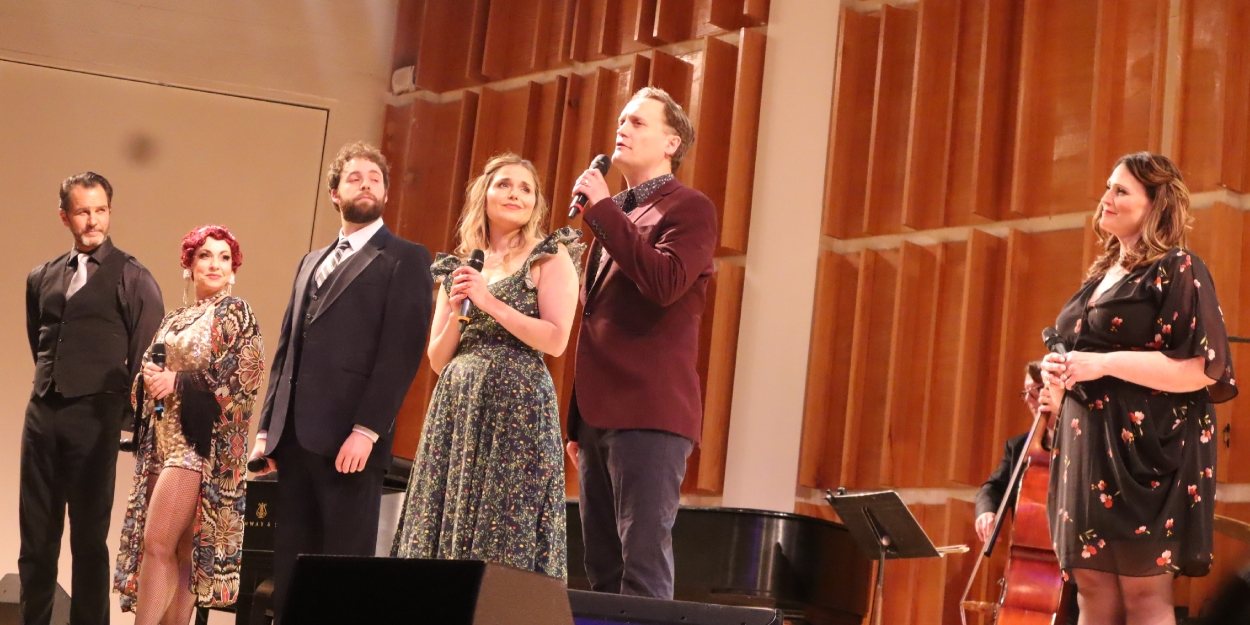Review: BROADWAY BY THE SEASON Shines a Spotlight on the Past at Merkin Hall
Guided musical tours through early Broadway seasons started with 1931-32 & 1942-43 and continue April 29 & June 17.

Raise your hand if you were around to go to Broadway shows about 80 or 90 years ago ... Anyone?
Well, the latest edition of the concert series Broadway by the Season was here to give you some highlights of two particular seasons: 1931-32 and 1942-43. Looks at other seasons will happen in the next programs of this series set for April 29 and June 17. The location is the attractive Merkin Concert Hall at the Kaufman Music Center on West 67th Street. On March 25, those who’ve been to host/producer/director/writer Scott Siegel’s prior events — at this venue, 54 Below, and elsewhere — found some of the talented “usual suspects” he’s presented in recent years, including ever-ready/steady musical director/pianist Ross Patterson, with drummer Eric Halvorson and bassist Adam Armstrong.
This auditorium’s stage, larger than those in cabarets, allows for the luxury of space to be used for full-out dance numbers which are highlights. Audience favorite Danny Gardner was again on hand (and feet) to dazzle, along with his troupe. Solo, he was the first performer of the evening, dancing and singing the philosophy — first trumpeted on Broadway by Ethel Merman – that “Life Is Just a Bowl of Cherries.” With that metaphor, the cheer he served up was as delicious as a dish of cherries jubilee. And that lets me segue into the next number performed, with the lyric that characterizes life in a different way: “Life is one long jubilee.”
It comes from “Who Cares? (So Long As You Care for Me)” and it was innovative to hear this item by the Gershwins interpreted in a way that veered from its usual tossed-off pep and cheer. Douglas Ladnier (in photo above) is a deep-voiced, soulful singer who could bring gravitas and hidden depth to “Mary Had a Little Lamb” if he cared to, made it seem to be about not taking a romantic relationship for granted, but really valuing it when other aspects of life are distressing. Both these lyrics reference the very real financial woes of their times, the lingering Depression, while trying to offer some perspective. The first reminds us that “You work, you save, you worry so/ But you can’t take your dough when you go…” and the second specifically mentions bank failures. (These first two numbers were, to me, also the most satisfying ones in the first half.) Mr. Siegel’s introduction to the first half of the program, sampling songs from the Broadway season of 1931-32, reminded the audience of the historical context, with some trivia tossed in (in 1931, home hair dye products were introduced and the Empire State Building was completed).
In the first half, Jenny Lee Stern had three “character” solo numbers that were overwhelmingly over-the-top. Bedecked in a flashy costume that threatened to upstage the material, she seemed to be pushing the envelope or pushing for laughs, and she certainly got some with the very funny “Torch Song” from Irving Berlin’s Face the Music.
The other singers handling things from the early ‘30s were Willie Demyan and Sophie Rapiejko who were far stronger in the second half of the night, doing lovely, nuanced things with selections from Oklahoma! –including Mr. Ladnier’s reverence-soaked appreciation of Nature with “Oh, What a Beautiful Mornin’,” allowing the landmark show to be granted three samples — which is a lot, considering the program presented a total of nine songs from the entire season being surveyed; and there were double-dips into two other musicals. That pair gave nods to the World War II era, also addressed via the grim facts in opening remarks about the 1942-43 season being put into context. This Is the Army enlisted the dancers for a romp through “Oh, How I Hate to Get Up in the Morning” with some clever slapstick with dancer/choreographer du jour Gardner taking the staged smacks. And that army guy earned his balladeer stripes with a disarmingly sweet “I Left My Heart at the Stage Door Canteen.” The Cole Porter score of Something for the Boys gave us the solidly entertaining work of Broadway veteran Lisa Howard with two picks that were splendid pick-me-ups — “Hey, Good Lookin’” and its title tune, enhanced by the participation of the dancers.
Lisa Howard also graced Merkin Hall by sailing through the ballad “My Ship” from Lady in the Dark. Mr. Siegel set it up as a sort of “bonus,” saying that he regretted not including it in an earlier night focused on the 1941-42 season. The musical certainly did debut in that season, but went on a multi-city tour and then opened again on Broadway in February of 1943, a month before Oklahoma! The evening ended on a humanistic, patriotic note, with the night’s six vocalists sharing “The House I Live In (That’s America to Me),” which had been in a revue that lasted only eight performances, Let Freedom Sing, but was taken on by Paul Robeson and Frank Sinatra (who sang it in a short film and kept it in his repertoire for decades). It was a potent and stirring ending, resonating in the context of our divided country where, alas, eight decades after the song’s debut, tolerance and acceptance of “all races and religions” and “a certain word: ‘democracy’” are still not fully embraced by all.
The other talented dancers joining Danny Gardner: Kelly Sheehan, Michael Schimmele, Craig Waletzko, and Jack Wunsch.
Info on Scott Siegel’s various music presentations can be found at www.SiegelPresents.com. Tickets and info for the April 29th show are online here.
Reader Reviews

Videos

